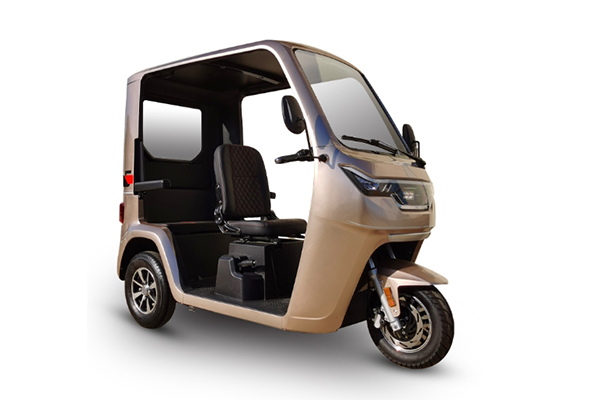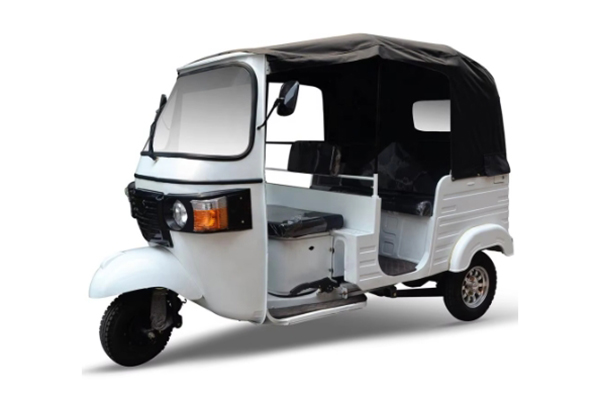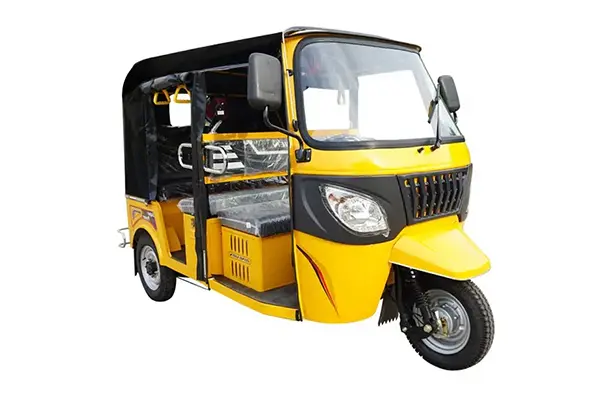The auto rickshaw, a vibrant and ubiquitous sight in many cities across Asia and parts of Africa and Latin America, is more than just a means of transportation; it’s a cultural icon and an economic engine. But the familiar sputtering sound of the internal combustion engine is gradually being joined, and in some cases replaced, by the quiet hum of the electric auto rickshaw. This article explores the world of the auto rickshaw, its evolution, its significance, and why the electric transition represents a major opportunity for businesses worldwide, particularly for fleet managers and distributors like Mark Thompson in the USA. We’ll delve into what makes these three-wheeled vehicles tick, the benefits of going electric, and what to look for when sourcing high-quality electric rickshaws directly from manufacturers like us, Allen’s electric tricycle factory in China. Whether you’re considering them for last-mile delivery, passenger transport, or distribution, understanding the auto rickshaw landscape is key.
What Exactly is an Auto Rickshaw?
An auto rickshaw is essentially a motorized version of the traditional pulled rickshaw or cycle rickshaw. It’s a three-wheeled cabin tricycle, primarily used as a vehicle for hire (taxi) or private transport in many developing countries. Characterized by its sheet-metal body resting on three wheels, a handlebar steering system (though some newer models adopt steering wheels), and typically a canvas roof with drop-down side curtains, the auto rickshaw is designed for efficient navigation through congested urban areas. The driver sits upfront, while the passenger compartment, usually accommodating two to three people, is located at the rear.
These vehicles serve as a crucial part of the public transport infrastructure, especially for short distances where larger buses or trains might be impractical or unavailable. They offer a relatively low-cost and flexible mode of transportation, capable of maneuvering through narrow streets and heavy traffic. While traditionally powered by two-stroke or four-stroke internal combustion engines (often running on petrol, LPG, or CNG auto fuel), the shift towards electric power is rapidly gaining momentum, creating the electric auto rickshaw.
The basic design, though varying slightly by region and manufacturer (Bajaj Auto, Piaggio, Mahindra being prominent names in the traditional market), remains focused on functionality and economy. They are built to be robust enough for daily use in demanding conditions yet simple enough for relatively easy maintenance. Think of them as the workhorses of urban mobility in a number of cities globally, efficiently transporting people and goods.

From Pulled Rickshaw to Motorized Marvels: A Quick History?
The story of the auto rickshaw begins long before engines were involved. The earliest form was the hand-pulled rickshaw, originating in Japan around 1869. This simple cart, pulled by a person on foot, quickly spread across Asia as a popular mode of transportation. Following this came the cycle rickshaw (or pedicab), which mounted the passenger cabin onto a bicycle frame, making the task less strenuous for the operator. These trishaws offered a step up in efficiency and became widespread.
The true revolution, however, was the decision to motorize the rickshaw. Inspired by scooter technology post-World War II, companies like Piaggio in Italy adapted their designs. Piaggio’s Ape (Italian for "bee"), launched in 1948, was essentially a Vespa scooter with two wheels at the back supporting a flatbed or cabin – arguably a precursor or parallel development to the three-wheeler auto rickshaw concept. In India, Bajaj Auto initially imported and later manufactured three-wheelers based on Italian designs in the late 1950s, becoming a dominant force in the market. These early motorized rickshaws offered significantly more speed and range than their human-powered counterparts.
The design evolved, moving from scooter-based fronts to more integrated cabin designs. Engines became more powerful, and fuel sources diversified from petrol to include LPG and CNG auto options, driven by cost and environmental concerns. The auto rickshaw cemented its place in the transport system of countless cities, adapting to local needs and regulations. Today, the history continues with the significant shift towards the electric auto rickshaw, promising a cleaner, quieter future for this iconic three-wheeler.
Are Auto Rickshaws the Same as Tuk-Tuks or Trishaws?
While the terms are often used interchangeably, especially by tourists, there are subtle distinctions, though context matters greatly. "Auto rickshaw" is the most general and widely understood term, particularly prevalent in South Asia (India, Pakistan, Bangladesh, Sri Lanka, Nepal). It specifically refers to the motorized three-wheeled vehicle we’ve been discussing.
"Tuk-tuk" is the term most commonly associated with Thailand, though its usage has spread globally as a colloquialism for any auto rickshaw. The name is onomatopoeic, supposedly mimicking the sound of the early two-stroke engines. So, functionally, a Thai tuk-tuk is a type of auto rickshaw, often characterized by its more open-air design compared to some Indian models.
"Trishaw" can be a bit broader. Historically, it often referred to the cycle rickshaw (pedal-powered). However, in some regions, particularly parts of Southeast Asia like Malaysia and Singapore (though less common now), "trishaw" might also be used colloquially for motorized versions. Essentially, "auto rickshaw" is the formal/technical term, "tuk-tuk" is a popular regional nickname that went global, and "trishaw" primarily refers to pedal-powered versions but can sometimes overlap with motorized ones depending on local lingo. For clarity, especially in a business context, "auto rickshaw" or "three-wheeler" is generally preferred, specifying "electric" when applicable.

Why Are Auto Rickshaws Such a Popular Mode of Transport?
The enduring popularity of the auto rickshaw stems from a confluence of factors perfectly suited to the environments where they thrive. Firstly, cost-effectiveness is paramount. Compared to a standard automobile taxi, the fare for an auto rickshaw ride is significantly lower, making it accessible to a broader segment of the population. Their operational costs (fuel, maintenance) are also generally lower than cars, which benefits the rickshaw drivers. Secondly, their size and maneuverability are huge advantages in densely populated urban areas. They can navigate narrow lanes, weave through traffic jams, and access areas inaccessible to larger vehicles, making them ideal for short distances and point-to-point travel.
Thirdly, they offer door-to-door convenience. Unlike buses or trains with fixed routes and stops, an auto rickshaw can often pick up and drop off passengers exactly where they need to go, offering a personalized taxi-like service. This flexibility is highly valued for commuting, running errands, or reaching specific destinations within a city. Rickshaws are a common form of transportation in a number of places because they fill a critical gap in the transport system.
Finally, their availability is key. In many cities offer auto rickshaw service, these vehicles are abundant, making it easy to hail one down on the street. This easy access, combined with their other benefits, makes the auto rickshaw a popular mode of transport and an indispensable part of daily life for millions. The transition to electric auto rickshaw models further enhances their appeal by addressing noise and air pollution concerns.
What Different Types of Auto Rickshaws Can You Find?
While the basic three-wheeled concept remains, auto rickshaws come in various configurations tailored to specific needs. The most common form of transportation is the passenger auto rickshaw. These are designed primarily for transporting people, typically featuring a covered cabin with seating for 2-4 passengers behind the driver. Variations exist in cabin design, from open-air tuk tuks popular in tourist spots to fully enclosed models offering better weather protection, like our versatile electric passenger tricycle models.
Another major category is the cargo auto rickshaw. These three-wheelers replace the passenger cabin with a cargo bed or container. They are workhorses for transporting goods, popular among small businesses, delivery services, and for agricultural use in rural areas. Load capacities can vary significantly depending on the model’s design and intended use. Examples include open-bed models for general freight or specialized enclosed versions like our electric cargo tricycle HJ20 or even refrigerated units. Some heavy-duty cargo models feature automatic unloading mechanisms for specific industrial applications.
Beyond these two main types of auto rickshaws, you might find specialized versions, such as waste collection vehicles, mobile vendor platforms, or modified accessible rickshaws. The fuel source also differentiates them: traditional models use petrol, diesel, LPG, or CNG auto fuel, while the rapidly growing segment uses electric power (electric auto rickshaw). The choice depends on the intended application, local regulations, and economic factors like fuel availability and fare structures.
The Rise of the Electric Auto Rickshaw: Why Go Green?
The shift towards the electric auto rickshaw is one of the most significant developments in the history of this vehicle. Driven by growing environmental awareness, government incentives, and advancements in battery technology, electric models offer compelling advantages over their internal combustion counterparts. The most obvious benefit is zero tailpipe emissions. Traditional auto rickshaws, especially older two-stroke models, are major contributors to urban air pollution and noise. Electric rickshaws eliminate localized emissions, leading to cleaner air and quieter streets, significantly improving the quality of life in congested cities.
Operational costs are another major driver. Electricity is generally cheaper per kilometer than petrol, LPG, or CNG auto fuel. Furthermore, electric vehicles have fewer moving parts in their powertrain (no complex engine, gearbox, or exhaust system), leading to significantly lower maintenance requirements and costs. This translates to higher potential profits for rickshaw drivers and fleet operators. Governments worldwide are recognizing these benefits, often offering subsidies, tax breaks, and preferential registration for electric vehicles, further accelerating the transition.
The performance of modern electric auto rickshaws is also competitive. Electric motors provide instant torque, resulting in quick acceleration, which is ideal for stop-and-go city traffic. Battery technology has improved dramatically, offering better range and faster charging times, addressing earlier concerns about practicality. As a factory specializing in these vehicles, we see firsthand the surging demand for environmentally friendly, efficient, and reliable electric three-wheelers. This isn’t just a trend; it’s the future mode of transportation for this segment.

What are the Key Business Advantages of Electric Auto Rickshaws?
For businesses, particularly those involved in logistics, delivery, or passenger transport, incorporating electric auto rickshaws into their fleet offers substantial advantages. The primary benefit, as mentioned, is reduced operating costs. Lower fuel (electricity) expenses and drastically reduced maintenance needs directly impact the bottom line, leading to better profitability per vehicle or per kilometer traveled. This is crucial for companies operating large fleets where even small savings per vehicle add up significantly.
Secondly, environmental responsibility and brand image are increasingly important. Utilizing a fleet of electric auto rickshaws demonstrates a commitment to sustainability, which can enhance brand reputation and appeal to environmentally conscious customers and clients. In some markets, this "green" image can be a significant competitive differentiator and may even be required for certain government contracts or partnerships. This aligns with growing corporate social responsibility (CSR) goals.
Thirdly, regulatory compliance and future-proofing are key considerations. Many cities and countries are implementing stricter emission standards or even planning bans on internal combustion engine vehicles in certain zones. Investing in electric auto rickshaws ensures compliance with current and future environmental regulations, avoiding potential fines or operational restrictions. It positions the business for long-term operation in evolving urban landscapes. Furthermore, the quieter operation of electric vehicles can allow for deliveries or services during noise-restricted hours in some areas.
Finally, operational efficiency in urban environments is a plus. The quick acceleration and maneuverability of these 3-wheeled vehicles, combined with their ability to navigate tight spaces, make them highly efficient for tasks like last-mile delivery or short-hop passenger services within cities. As a manufacturer, we design our electric tricycle models, like the Van-type logistics electric tricycle HPX10, specifically to maximize these operational benefits for businesses.
How Can Fleet Managers Like Mark Benefit from an Electric Tricycle Fleet?
Fleet managers like Mark Thompson, who are decisive, quality-conscious, and focused on reliable performance for their delivery or transport businesses in the USA, stand to gain significantly by adopting electric auto rickshaw (or more broadly, electric tricycle) fleets sourced from reliable manufacturers. Mark’s key concerns – battery range/lifespan, motor reliability, build quality, regulatory compliance, parts availability, and overall cost-effectiveness – align perfectly with the strengths of well-manufactured electric models and the advantages of sourcing directly.
Mark’s primary goal is likely maximizing ROI for his fleet. Electric auto rickshaws directly address this through:
- Lower Total Cost of Ownership (TCO): While the initial purchase price might sometimes be higher than a traditional auto rickshaw (though competitive sourcing helps), the savings on fuel and maintenance over the vehicle’s lifespan typically result in a lower TCO.
- Predictable Expenses: Electricity prices tend to be more stable than volatile fossil fuel prices (like petrol or CNG auto). Maintenance needs are simpler and less frequent, making budgeting more predictable.
- Increased Uptime: Less time spent on maintenance means more time on the road generating revenue. Reliable components minimize unexpected breakdowns.
Addressing Mark’s pain points:
- Quality Consistency: Partnering with a reputable factory like ours, with established production lines and quality control processes, mitigates the risk of inconsistent quality across batches – a common issue when sourcing from less established suppliers.
- Battery Performance: We offer various battery options tailored to different range needs and operating conditions, utilizing high-quality cells designed for durability and performance across temperature ranges. Transparency about battery specifications and lifespan is crucial.
- Reliability & Durability: Our focus on high-quality motors, robust frames, and durable construction directly addresses Mark’s need for vehicles that can withstand the rigors of daily commercial use.
- Regulatory Compliance: We work with clients to ensure vehicles meet relevant safety standards and import regulations for markets like the USA, assisting with the necessary documentation.
- After-Sales Support: As a factory, we can ensure the availability of spare parts and provide technical support, addressing concerns about long-term maintenance.
By sourcing cost-effective yet high-quality electric auto rickshaws directly, Mark can build a modern, efficient, and sustainable fleet that meets his business objectives and overcomes the typical challenges associated with international procurement.
Sourcing Electric Auto Rickshaws: What Should Buyers Prioritize?
When sourcing electric auto rickshaws, especially for B2B purposes like building a fleet, buyers like Mark need to look beyond just the initial price tag. Prioritizing certain factors is crucial for long-term success and reliability. First and foremost is Build Quality and Durability. Assess the materials used for the frame, body panels, and suspension. Look for robust construction designed to handle daily wear and tear, varied road conditions, and potential cargo loads. The longevity of the three-wheeler depends heavily on its structural integrity.
Second, Powertrain Components (Motor and Battery) are critical. Inquire about the motor type (e.g., brushless DC), power rating, and efficiency. Most importantly, scrutinize the battery specifications: type (e.g., Lithium-ion, Lead-acid), capacity (Ah/kWh), claimed range per charge (ensure this is realistic for typical operating conditions), estimated lifespan (charge cycles), and warranty. Battery quality directly impacts performance, reliability, and long-term operating costs. Understand the charging requirements and compatibility with local infrastructure.
Third, Safety Features and Compliance. Ensure the electric auto rickshaw meets relevant safety standards for the target market (e.g., braking systems, lighting, structural integrity). This includes checking for certifications if required for import and operation (like DOT requirements in the USA, although regulations for three-wheelers can vary). Reliable rickshaw manufacturers should be transparent about compliance.
Fourth, After-Sales Support and Spare Parts Availability. A reliable supplier should offer clear warranty terms and demonstrate a commitment to providing spare parts for a reasonable period. Difficulty in obtaining parts can lead to extended vehicle downtime, impacting business operations. Discuss the process for ordering spares and technical support availability. This is often a key advantage of working directly with a dedicated rickshaw company or factory.
Successfully importing and operating a fleet of electric auto rickshaws involves navigating several complex areas. Quality Control is paramount. As Mark knows, inconsistent quality can plague imports. It’s essential to establish clear quality standards with the manufacturer. This might involve specifying component brands, requesting batch testing reports, or even arranging third-party inspections before shipment. Visiting the factory, if feasible, provides invaluable insight into production processes and quality commitment. A trustworthy partner will be transparent about their QC procedures.
Understanding Regulations is non-negotiable. Import duties, safety certifications (like FMVSS in the US, though applicability to three-wheelers varies), homologation requirements, and state/local licensing rules for operating electric auto rickshaws or tricycles must be thoroughly researched. What’s permissible in India or Thailand might differ vastly from requirements in the USA or Europe. Partnering with a manufacturer experienced in exporting to your specific market (like our experience with the USA, North America, and Europe) can significantly ease this process, as they often have familiarity with common requirements. Missteps here can lead to costly delays, fines, or inability to operate the vehicles legally.
Building a Strong Partnership with the supplier is key for long-term success. Look beyond a purely transactional relationship. A good partner communicates effectively, understands your business needs (like specific customizations or delivery schedules), acts proactively to address potential issues, and is invested in your success. This involves clear contracts covering specifications, payment terms (addressing Mark’s concern), warranties, delivery schedules, and intellectual property if customizations are involved. Attending industry exhibitions can be a great way to meet potential partners face-to-face and assess their professionalism, as Mark often does.
Why Partner with a Specialized Electric Rickshaw Manufacturer?
For businesses serious about deploying electric auto rickshaws, partnering directly with a specialized manufacturer like us, Allen’s factory in China, offers distinct advantages over sourcing through intermediaries or general trading companies. Expertise and Focus: A specialized manufacturer possesses deep technical knowledge about electric tricycle design, engineering, battery management systems, and motor technology. This expertise translates into better-designed, more reliable, and optimized vehicles. We understand the nuances of balancing performance, range, durability, and cost.
Customization Potential: Direct partnership allows for greater flexibility in customizing vehicles to specific needs. Whether it’s adjusting cargo box dimensions, integrating specific features (like GPS tracking or enhanced lighting), choosing specific battery chemistries, or branding the vehicles, a manufacturer can often accommodate these requests more effectively and efficiently than a reseller. This ensures the final product, whether it’s an electric passenger model like the EV31 or a cargo workhorse, perfectly fits the intended application.
Cost-Effectiveness and Transparency: Buying directly from the factory eliminates intermediary markups, often resulting in more competitive pricing, especially for bulk orders – addressing Mark’s preference for value. Furthermore, direct communication fosters transparency regarding production processes, component sourcing, quality control, and lead times. This builds trust and allows for better planning. We pride ourselves on offering high-quality components and durable construction while maintaining competitive factory-direct pricing for our clients in the USA, Europe, and beyond.
Streamlined Support: When issues arise or spare parts are needed, dealing directly with the manufacturer streamlines the support process. There are fewer communication layers, leading to faster response times and more accurate technical assistance. We understand the importance of minimizing downtime for commercial fleets and prioritize efficient after-sales service for our partners. This direct line addresses Mark’s key concern about reliable long-term maintenance support.
Key Takeaways:
- Auto Rickshaws are versatile three-wheeled vehicles, crucial for urban transport, evolving from pulled rickshaws to motorized and now electric versions.
- Electric Auto Rickshaws offer significant benefits: zero emissions, lower operating costs (fuel, maintenance), quieter operation, and often government incentives.
- Businesses (delivery, logistics, transport) can gain competitive advantages through electric auto rickshaw fleets due to reduced TCO, enhanced brand image, regulatory compliance, and operational efficiency.
- When sourcing, prioritize build quality, powertrain components (especially battery life/range), safety features/compliance, and reliable after-sales support/parts.
- Navigating quality control, complex regulations, and building strong supplier partnerships are vital for successful importation and operation.
- Partnering directly with a specialized electric rickshaw manufacturer like us offers expertise, customization, cost-effectiveness, and streamlined support, addressing the key concerns of buyers like Mark Thompson.
Post time: 04-14-2025




